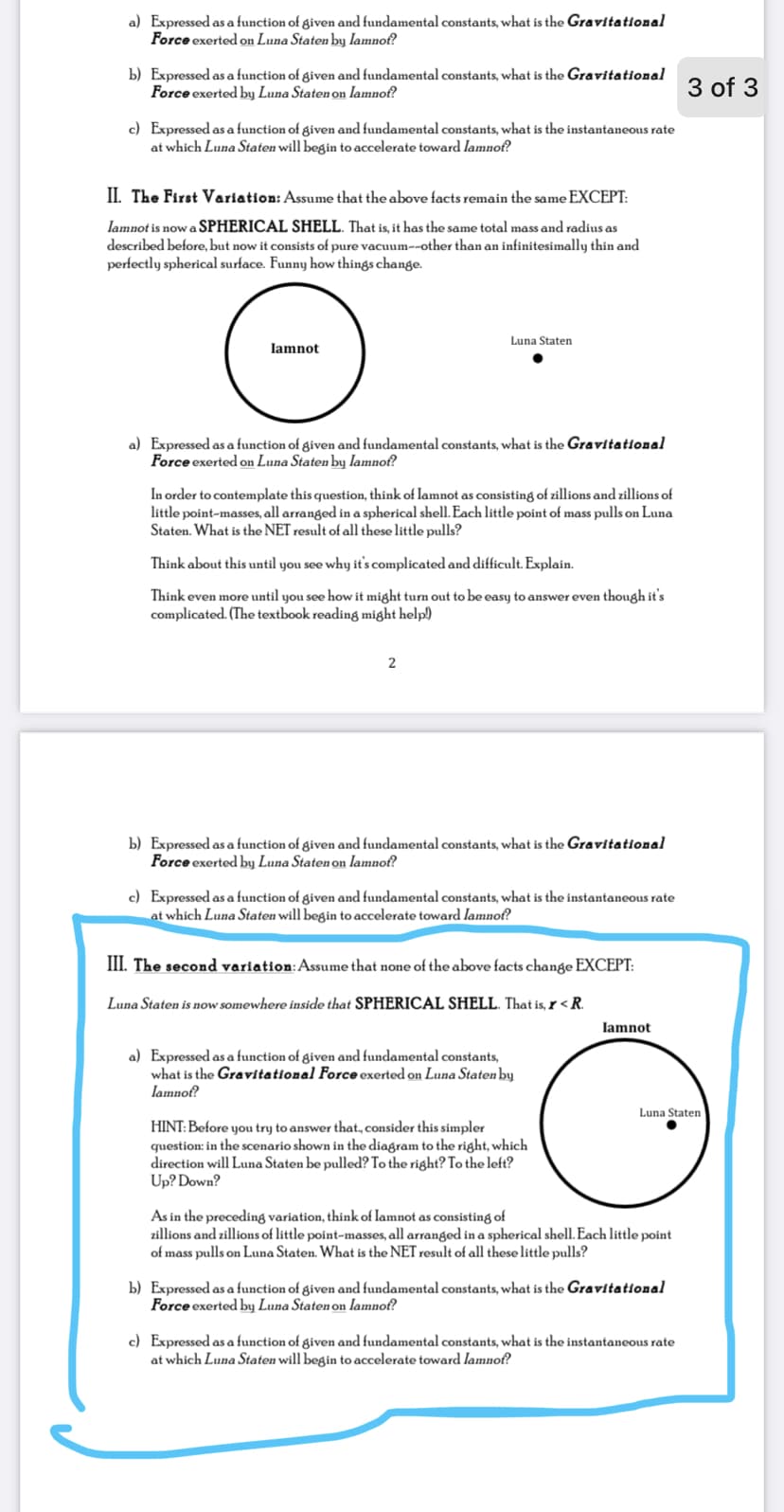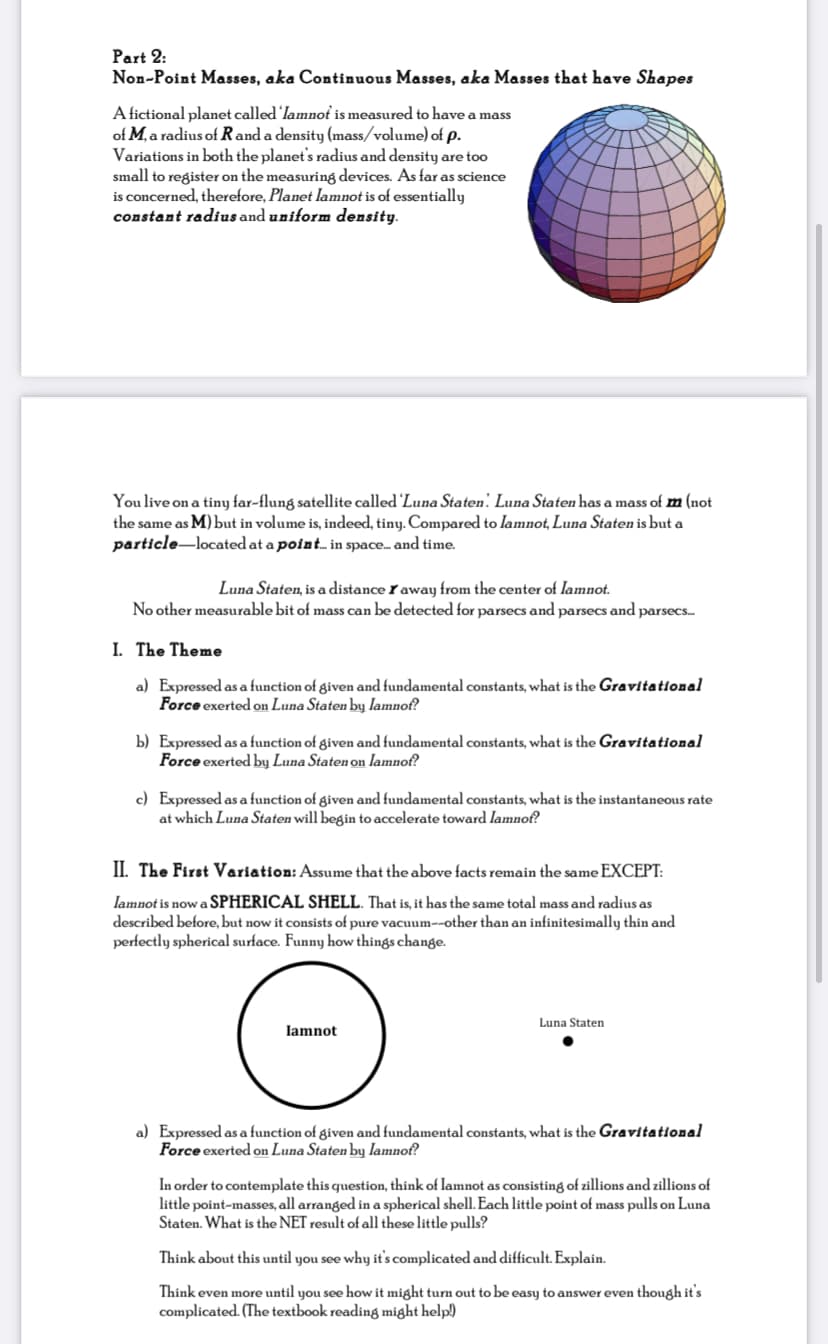Luna Staten is now somewhere inside that SPHERICAL SHELL. That is, r
Related questions
Question
Please only do part III . The second variation! it's in the blue box!
please show all the work! Thanks so much!

Transcribed Image Text:a) Expressed as a function of given and fundamental constants, what is the Gravitational
Force exerted on Luna Staten by lamnof?
b) Expressed as a function of given and fundamental constants, what is the Gravitational
Force exerted by Luna Staten on lamnof?
3 of 3
c) Expressed as a function of given and fundamental constants, what is the instantaneous rate
at which Luna Staten will begin to accelerate toward Iamnof?
II. The First Variation: Assume that the above facts remain the same EXCEPT:
lamnot is nowa SPHERICAL SHELL. That is, it has the same total mass and radius as
described before, but now it consists of pure vacuum--other than an infinitesimally thin and
perfectly spherical surface. Funny how things change.
Luna Staten
Iamnot
a) Expressed as a function of given and fundamental constants, what is the Gravitational
Force exerted on Luna Staten by lamnof?
In order to contemplate this question, think of lamnot as consisting of zillions and zillions of
little point-masses, all arranged in a spherical shell. Each little point of mass pulls on Luna
Staten. What is the NET result of all these little pulls?
Think about this until you see why it's complicated and difficult. Explain.
Think even more until you see how it might turn out to be easy to answer even though it's
complicated. (The textbook reading might help)
b) Expressed as a function of given and fundamental constants, what is the Gravitational
Force exerted by Luna Staten on lamnof?
c) Expressed as a function of given and fundamental constants, what is the instantaneous rate
at which Luna Staten will begin to accelerate toward lamnof?
III. The second variation:Assume that none of the above facts change EXCEPT:
Luna Staten is now somewhere inside that SPHERICAL SHELL. That is, r < R.
lamnot
a) Expressed as a function of given and fundamental constants,
what is the Gravitational Force exerted on Luna Staten by
lamnof?
Luna Staten
HINT: Before you try to answer that, consider this simpler
question: in the scenario shown in the diagram to the right, which
direction will Luna Staten be pulled? To the right? To the left?
Up? Down?
As in the preceding variation, think of lamnot as consisting of
zillions and zillions of little point-masses, all arranged in a spherical shell. Each little point
of mass pulls on Luna Staten. What is the NET result of all these little pulls?
b) Expressed as a function of given and fundamental constants, what is the Gravitational
Force exerted by Luna Staten on Iamnof?
c) Expressed as a function of given and fundamental constants, what is the instantaneous rate
at which Luna Staten will begin to accelerate toward lamnof?

Transcribed Image Text:Part 2:
Non-Point Masses, aka Continuous Masses, aka Masses that have Shapes
A fictional planet called 'lamnot is measured to have a mass
of M, a radius of Rand a density (mass/volume) of p.
Variations in both the planet's radius and density are too
small to register on the measuring devices. As far as science
is concerned, therefore, Planet lamnot is of essentially
constant radius and uniform density.
You live on a tiny far-flung satellite called 'Luna Staten. Luna Staten has a mass of m (not
the same as M) but in volume is, indeed, tiny. Compared to lamnot, Luna Staten is but a
particle-located at a point.. in space... and time.
Luna Staten, is a distance I away from the center of lamnot.
No other measurable bit of mass can be detected for parsecs and parsecs and parsecs.
I. The Theme
a) Expressed as a function of given and fundamental constants, what is the Gravitational
Force exerted on Luna Staten by lamnof?
b) Expressed as a function of given and fundamental constants, what is the Gravitational
Force exerted by Luna Staten on lamnof?
c) Expressed as a function of given and fundamental constants, what is the instantaneous rate
at which Luna Staten will begin to accelerate toward lamnof?
II. The First Variation: Assume that the above facts remain the same EXCEPT:
lamnot is now a SPHERICAL SHELL. That is, it has the same total mass and radius as
described before, but now it consists of pure vacuum--other than an infinitesimally thin and
perfectly spherical surface. Funny how things change.
Luna Staten
lamnot
a) Expressed as a function of given and fundamental constants, what is the Gravitational
Force exerted on Luna Staten by lamnof?
In order to contemplate this question, think of lamnot as consisting of zillions and zillions of
little point-masses, all arranged in a spherical shell. Each little point of mass pulls on Luna
Staten. What is the NET result of all these little pulls?
Think about this until you see why it's complicated and difficult. Explain.
Think even more until you see how it might turn out to be easy to answer even though it's
complicated. (The textbook reading might help)
Expert Solution
This question has been solved!
Explore an expertly crafted, step-by-step solution for a thorough understanding of key concepts.
This is a popular solution!
Trending now
This is a popular solution!
Step by step
Solved in 2 steps with 1 images
